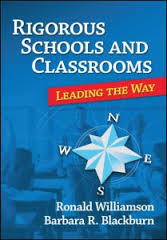4 Steps to Put School Data to Good Use
 By Ronald Williamson
By Ronald Williamson
and Barbara Blackburn
A critical aspect of school reform for today’s schools is the ability to effectively manage data. Leaders and teachers are often overwhelmed with the sheer amount of data they have. Many of the schools we work with are unsure how to best use the information.
First, let’s clarify what we mean by data. Data is all the information you have, or might collect, that you can use to support your efforts to make your school more rigorous and successful. When used correctly, data can be an important tool to guide the decision-making process, measure progress, and monitor accountability.
We suggest a four-step process when you use data to support your efforts to improve the rigor of your school.
Four Step Approach
Step 1: Be clear about what you want to know
Step 2: Decide how to collect the data
Step 3: Analyze the data
Step 4: Set priorities and goals
Step 1: Be Clear About What You Want to Know

You might want to begin with a focus on one part of our definition of rigor: rigor is creating an environment in which each student is expected to learn at high levels, each student is supported so he or she can learn at high levels, and each student demonstrates learning at high levels. For example, you begin by focusing on student support, and look at how that is provided across your school to promote student learning.
Step 2: Determine the Data You Need
After you’ve determined a focus area, you will want to think about the data you already have available. Most schools routinely gather data. Think about what you already have and how it might be used to guide your work.
Examples of Frequently Available Data
♦ Student grades or test scores
♦ Student, parent, and staff surveys
♦ School climate data
♦ Curriculum audit results
♦ Audit of rigor by an external expert
♦ Report of alignment with state or national standards
You will probably find some of these data helpful. But you may also find that you need additional, more targeted data to give you the information needed to support your work. You probably have demographic data about your students, and you probably have data about student achievement and learning. You may want more information about the instructional activities in your classrooms or information about the perceptions of students and families.
There are lots of different ways to collect data. We believe it is helpful to have a mix of quantitative measures and qualitative measures. For example, student grades and test scores might be complemented by open-ended surveys or focus group conversations.
Strategy: Conduct a Student Shadow Study

A more formal protocol, originally developed by NASSP (Lounsbury & Johnston, 1985), charts the experience of particular students every five-to-seven minutes. This allows the observer to show the ebb and flow of activities during the day by spending the entire day with a student and documenting their experience.
Shadowing provides interesting insights into the student experience. Of course, students quickly figure out that something is going on. The best approach is to talk with the student and assure them that you are not gathering information about them to report to the office but want to see what their day is really like.
Step 3: Analyze the Data
Be sure to involve your school improvement team or other shared governance group in the process of analyzing the data. We’ve always found it helps to have people with many different points of view look at data. Always keep an open mind, rather than pre-determining the results. Otherwise, you may not see the full picture.
First, analyze the information provided by each data source. One thing you will want to do is look for patterns. This will prove helpful when you begin to prioritize action steps in areas that need the most work. You may find that you don’t have enough data to select an area of focus. If so, consider how you might gather additional data.
Once you have looked at individual data sources, look for patterns across multiple sources of data. In many ways this is more beneficial, because it provides a clearer picture of what is happening both “vertically” and “horizontally” across your school.
Step 4: Set Priorities and Goals

This is a pivotal point. Too often, we gather and analyze data, set goals, but then do not use that information to make decisions on an ongoing basis.
Using your Pattern Analysis, note the data sources you used. Next, identify the area for potential growth, such as incorporating more activities in which each student is required to demonstrate learning. Third, design a specific way to track success. How will everyone know if they are making progress toward the goal? What does success look like? Finally, detail the specific action steps that are needed to accomplish the goal.
A Final Note
In today’s age of accountability, we are often overwhelmed by data. However, we are not always able to use the data effectively, and, sometimes, we do not have the correct types of data. It’s important to consider all aspects of the data review process, and implement changes based on what you find.
Resources: Books like Victoria Bernhardt’s Data Analysis for Continuous School Improvement (3rd Ed.) and Karen Sanzo’s Formative Assessment Leadership can help. If you have found other books effective in using data for planning, please share in the comments.
_____

Barbara Blackburn is a best-selling author of 14 books, including Rigor is NOT a Four-Letter Word. A nationally recognized expert in the areas of rigor and motivation, she collaborates with schools and districts for professional development. Barbara can be reached through her website or her blog. She’s on Twitter @BarbBlackburn. See her other MiddleWeb posts here. Her latest book, Rigor in Your Classroom: A Toolkit for Teachers, was published in May 2014.




























